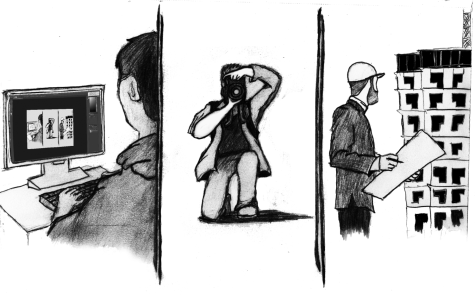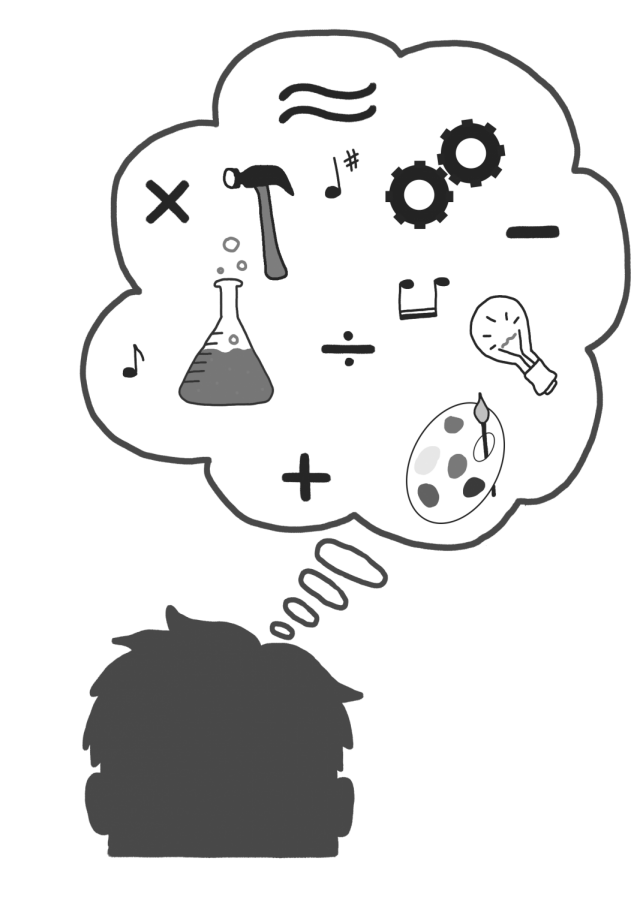©HAWKEYE image credit: Sierra Clark
The hidden program pathways
Students have more career-based education options outside of STEM than they think.
What makes each high school in the Edmonds School District (ESD) unique? Edmonds Woodway has the International Baccalaureate program, Meadowdale focuses on art and music, Scriber Lake is an alternative schooling option and Mountlake Terrace High School (MTHS) has the STEM Program. However, MTHS has a lot more to offer than just STEM.
MTHS has many pathways available to its students, but most students don’t know about them. The school has a total of eight Career and Technical Education (CTE) programs. Each program has its own set of pathways to participate in. There are a total of fourteen CTE pathways.
First, we have the Architecture and Construction Program, which is for students who want to design or build structures. The program has two pathways, the Carpentry and Building pathway and the Drafting and Design pathway.
The Business and Marketing Program is for students interested in business, marketing, management and finance. There is only one pathway for this program, which is the Business and Marketing Pathway.
The STEM Program, one of MTHS’ best-known programs, is a program revolving around science, technology, engineering and mathematics – hence the acronym STEM. The pathways in the program are Aerospace, Biotechnology and Computer Programming.
The Health Services Program is for students interested in healthcare. There is only one pathway, which is the Healthcare Careers Pathway.
Human Services Program is for students interested in helping other people with various needs. This program includes three pathways which are ASL/Sign Language Interpreter Pathway, the Family and Consumer Science Pathway and the Emergency and Protective Services Pathway.
The Information Technology Program is for students interested in computer software, hardware and programming. There is only one pathway which is the IT/Computer Science Pathway.
Engineering and Manufacturing Program, which is very similar to the Aerospace Pathway in Stem, is for students interested in the design and manufacturing of products and systems that improve standards of living. However, this program is not the same as STEM, as the classes required are a bit more unique than the required Aerospace classes. There is only one pathway which is called the Engineering and Manufacturing.
Last but not the least, the Applied Arts and Communications Program is for students interested in developing their creativity and technical and communication skills. Students can use what they learn in future careers such as numerous fields of photography, journalism, video production, graphic design and theatre. The pathways in this program are the Broadcasting and Journalism Pathway and Visual Communications Pathway.
Participants in any of these programs can get a short-term certificate, apprenticeship or an two or four year degree through a specialized program. This leads to the main question: Why don’t many people know about these pathways and why aren’t they promoted as much as STEM?
Angelo Comeaux, who is a CTE teacher of the Applied Arts and Communications Program and the supervisor for Hawk Broadcasting Network (HBN), has some information on the many pathways. He believes that all the CTE programs can technically be considered apart of STEM. Programs like the Applied Arts and Communications and Information Technology, he explained, have technological aspects but are not considered a part of the STEM program.
The reason for this goes back to the development of the STEM program and its pathways, and whether STEM should include art and become STEAM. The ESD decided the program would exclude art, becoming STEM, not STEAM.
“That’s how it’s defined at Terrace,” Comeaux said. “Other places have their own way of defining STEM. The school wants to focus on the three highest employment areas and everyone else was left on the platform.” By “everyone else,” Comeaux means the other CTE programs.
While MTHS promotes the big STEM pathways (Aerospace, Bioscience and Computer Programming), other programs suffer from a lack of exposure.
Katie Barry, a sophomore whose future plans include a business career, said that if she knew about the Business and Marketing program sooner, she would have participated in it.
“STEM is very good at promoting its side of things, but business and marketing should be included in that because Business and Marketing can branch out into different soft skills and things such as communications, working well with others and I think that they’re equally as important,” Barry said.
Another sophomore, Charlotte Janeway, agrees.
“The reason why I came to Mountlake Terrace High School was for the STEM program, and at that time I didn’t know exactly what I wanted to do, so it would have been nice to know about all the programs here, so I could have more options of at the beginning,” Janeway said. “Now realizing that I only knew about the STEM program and I had no idea about what the others are, I think it would have been nice to be aware about those programs, especially in middle school.”
Comeaux believes the best way to promote alternate CTE programs is for the leads of each pathway to have similar welcome nights like STEM. For example, Business and Marketing could host a welcome night with plenty of information about the pathways. Events like these would not only easily spread the word about the programs, it also will attract incoming freshman. Furthermore, CTE clubs often participate in competitions. By better publicizing the results of these competitions, the school could better promote alternate CTE experiences.
Let’s say that a STEM student wants to do both a CTE program and a STEM program, but they feel they can’t do both. However, this is not the case, as they can actually do both programs, with STEM classes occupying one elective slot and CTE classes occupying the other elective slot. Comeaux describes it as a major and a minor elective for college. The major elective would be STEM, the minor elective would be CTE.
Even if it’s too late to sign up for a CTE class, students can still participate in a CTE club. There are a total of 19 CTE clubs at MTHS, including everything from HBN to ASL to the Jewelry and Metals clubs. Last school year, a total of 791 students participated in CTE clubs. 190 of those students won awards for their respective clubs. More information about this program can be found on the Edmonds School Districts CTE website, found here.
 Salman Ghous
Salman Ghous

